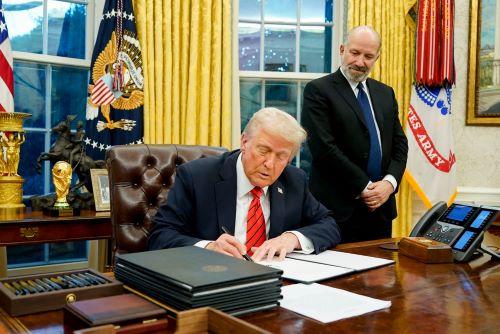
Donald Trump was inaugurated as the 47th president of the United States on January, marking one of the most momentous comebacks in U.S. political history. The hindrances that Trump defied in the election campaign, like assassination attempts and criminal charges, foreshadow uncertainties in his second term. Among key drivers behind Trump’s win was the economy, particularly inflation. His recent pronouncements on tariffs and trade policies, which frame them as necessary to protect the U.S. from harmful world markets, have drawn much attention. Many major U.S. trading partners could be affected, leading to a global trade war. In this article, the Chonnam Tribune examines Trump’s tariff policies and the world’s response.
Trump’s Tariffs and US National Interests
On Feb. 1, Trump issued three executive orders directing the U.S. to implement an additional 25 percent tariff on imports from Canada and Mexico and a 10 percent tariff on imports from China. Energy resources from Canada will face a lower 10 percent tariff. An official announcement on the White House’s website indicates that tariffs serve to leverage America’s economic position in order to secure its borders against illegal migration and combat the flow of contraband drugs from Mexico, Canada, and China.
Furthermore, Trump issued proclamations to launch a 25 percent tariff on steel and aluminum and signed the “Fair and Reciprocal Plan” to “restore fairness” in U.S. trade relationships while countering non-reciprocal trading arrangements. Trump showed his commitment to strengthening domestic industries and shielding American companies and innovators from overseas pressure. According to Reuters on Jan. 23, Trump’s trade policy explicitly aims to use revenue from higher tariffs on imported goods to pay for extending trillions of dollars in personal and corporate tax cuts. “Instead of taxing our citizens to enrich other countries, we will tariff and tax foreign countries to enrich our citizens. It will be massive amounts of money pouring into our Treasury from foreign sources,” Trump said during his inaugural address.
Tighter Control and Careful Approaches
According to Global News on Feb. 2, Canadian Prime Minister Justin Trudeau imposed retaliatory tariffs of 25 percent on $155 billion worth of U.S. goods in response to Trump’s tariffs. These tariffs include American beer, wine, bourbon, fruits, fruit juices, and vegetables. Canada’s tariffs also target clothing, sports equipment, and household appliances. Canada is contemplating non-tariff measures centered around the supply of critical minerals and energy procurement. Trudeau encouraged Canadian companies and supply chains to seek alternatives and urged Canadians to buy local goods while standing in solidarity with others.
Following Trump’s tariff announcement, Mexico vowed reprisal to the U.S. economy without specific plans. According to Mexico News Daily on Feb. 3, Mexican President Claudia Sheinbaum posted on X, “Mexico does not want confrontation. We start from the collaboration between neighboring countries. We must work together in a comprehensive manner, but always under the principles of shared responsibility, mutual trust, collaboration, and above all, respect for sovereignty, which is non-negotiable.” To gain Trump’ s agreement to pause plans to impose tariffs of 25 percent on Mexico and Canada, Sheinbaum and Trudeau offered to strengthen border security with the U.S.
Resisting Regulations
According to the South China Morning Post on Feb. 6, China has issued more carefully calibrated responses than its reactions when Trump imposed tariffs in 2018. China has filed a complaint against the U.S. levies with the World Trade Organization. Chinese officials also announced a 15 percent tariff on coal and liquefied natural gas products and a 10 percent tariff on crude oil, agricultural machinery, and large-engine cars imported from the U.S. Besides the tariff hikes, China’s Ministry of Commerce also imposed export controls on five critical minerals—tungsten, tellurium, bismuth, molybdenum, and indium—as well as certain metallic compounds derived from them, which are claimed to be essential to the U.S. economy and have supply chains vulnerable to disruption.
In his public interview with reporters on Feb. 19, Trump accused the European Union of unfair practice against the U.S. For instance, while the EU can freely export shellfish to the U.S., it prohibits shellfish exports from 48 U.S. states. The Reciprocal Act serves as a response. Trump hinted at launching tariffs on the EU and threatened sweeping new tariffs on all imported goods. According to the official website of the European Commission on Feb. 13, “The European Commission views President Trump’s proposed ‘reciprocal’ trade policy as a step in the wrong direction. The EU will react firmly and immediately against unjustified barriers to free and fair trade.” Economists say Trump’s reciprocal tariffs are a crucial test of EU unity.
What’s Next?
Trump’s trade policies have reignited global tensions, setting the stage for a trade war with major U.S. partners. According to Korea JoongAng Daily on Feb. 7, South Korea has been communicating with the U.S. to reduce uncertainties affecting domestic industries after Trump’s tariffs. Trade Minister Cheong In-kyo made remarks during a meeting with think tanks to discuss Seoul’s strategy for Trump’s tariffs. As the world responds, the coming months will reveal whether these policies achieve their intended goals or lead to broader economic and geopolitical instability. The international community faces a critical challenge in balancing economic security with global cooperation.
By Hoang Thi Le Tra, Editor

